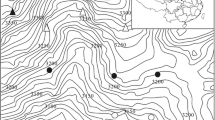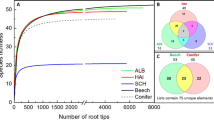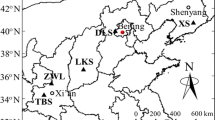Abstract
Spatial distribution of ectomycorrhizae-associated basidiomycetes was determined in oakbirch forest using terminal restriction fragment length polymorphism (T-RFLP) analysis. The data were correlated with actual soil humidity, pH, electric conductivity of the soil extract, absorbance A 465 and A 665 of water and alkali soil extracts and with the ratio A 465/A 665 (parameter A4/A6). Natural non-homogeneity of the soil parameters was used as experimental gradient. Distance-based redundancy analysis of the T-RFLP data (with soil parameters being taken as environmental parameters) provided significant results when ITS1F-terminanted restriction fragments were analyzed. Among other fungi, a Mycena galericulata related fungus was observed to correlate negatively with A4/A6, indicating its association with highly humified soil organic matter. Positive association of other, unidentified fungi with A4/A6 was also observed. Several other unidentified fungi negatively correlated with electric conductivity of the soil extract. The results may explain nonhomogeneity of the spatial distribution of the fungi associated with ectomycorrhizae as a result of their interaction with non-homogeneous soil environment.
Similar content being viewed by others
Abbreviations
- A4/A6:
-
ratio A 465/A 665
- BLAST:
-
basic local alignment search tool
- BSA:
-
bovine serum albumin
- dbRDA:
-
distance-based redundancy analysis
- DTT:
-
1,4-dithiothreitol
- ECMe:
-
ectomycorrhizae
- ECMl:
-
ectomycorrhizal
- FAM:
-
6-carboxyfluorescein
- HEX:
-
6-carboxy-4,7,2′,4′,5′,7′-hexachlorofluorescein
- ITS:
-
internal transcribed spacer (in rRNA gene cassette)
- RF:
-
related fungus
- ROX:
-
6-carboxy-X-rhodamine
- SAE:
-
soil alkali extract
- SWE:
-
soil water extract
- TRF(s):
-
terminal restriction fragment(s)
- T-RFLP:
-
terminal restriction fragment length polymorphism
References
Agerer R., Grote R., Raidl S.: The new method ‘micromapping’, a means to study species specific associations and exclusions of ectomycorrhizae. Mycol.Progr.1, 155–166 (2002).
Baldrian P.: Ectomycorrhizal fungi and their enzymes in soils: is there enough evidence for their role as facultative soil saprotrophs? Oecologia161, 657–660 (2009).
Bougoure D.S., Parkin P.I., Cairney J.W.G., Alexander I.J., Anderson I.C.: Diversity of fungi in hair roots of Ericaceae varies along a vegetation gradient. Mol.Ecol.16, 4624–4636 (2007).
Cavender-Bares J., Izzo A., Robinson R., Lovelock C.E.: Changes in ectomycorrhizal community structure on two containerized oak hosts across an experimental hydrologic gradient. Mycorrhiza19, 133–142 (2009).
Chen Y., Senesi N., Schnitzer M.: Information provided on humic substances by E4/E6 ratios. Soil Sci.Soc.Am.J.41, 352–358 (1977).
Dickie I.A., Xu B., Koide R.E.: Vertical niche differentiation of ectomycorrhizal hyphae in soil as shown by T-RFLP analysis. New Phytol.156, 527–535 (2002).
Fernández-toirán L.M., Ágreda T., Olano J.M.: Stand age and sampling year effect on the fungal fruit body community in Pinus pinaster forests in central Spain. Can.J.Bot.84, 1249–1258 (2006).
Gardes M., Bruns T.D.: ITS primers with enhanced specificity for basidiomycetes — application to the identification of mycorrhizae and rusts. Mol.Ecol.2, 113–118 (1993).
Grant A., Ogilvie L.A.: Terminal restriction fragment length polymorphism data analysis. Appl.Environ.Microbiol.69, 6342–6343 (2003).
Gryndler M., Rohlenová J., Kopecký J., Matucha M.: Chloride concentration affects soil microbial community. Chemosphere71, 1401–1408 (2008).
Hartmann M., Enkerli J., Widmer F.: Residual polymerase activity-induced bias in terminal restriction fragment length polymorphism analysis. Environ.Microbiol.9, 555–559 (2007).
Jackson R.B., Caldwell M.M.: Geostatistical patterns of soil heterogeneity around individual perennial plants. J.Ecol.81, 683–692 (1993).
Luis P., Kellner H., Zimdars B., Langer U., Martin F., Buscot F.: Patchiness and spatial distribution of laccase genes of ectomycorrhizal, saprotrophic, and unknown basidiomycetes in the upper horizons of a mixed forest cambisol. Microb.Ecol.50, 570–579 (2005).
Newton A.C., Haigh J.M.: Diversity of ectomycorrhizal fungi in Britain: a test of the species-area relationship, and the role of host specificity. New Phytol.138, 619–627 (1998).
Řezáčová V., Hršelová H., Gryndlerová H., Mikšík I., Gryndler M.: Modifications of degradation-resistant soil organic matter by soil saprobic microfungi. Soil Biol.Biochem.38, 2292–2299 (2006).
Soukupová L., Hršelová H., Gryndlerová H., Merhautová V., Gryndler M.: Alkali-extractable soil organic matter: an important factor affecting the mycelial growth of ectomycorrhizal fungi. Appl.Soil Ecol.40, 37–43 (2008).
Taylor A.F.S.: Fungal diversity in ectomycorrhizal communities: sampling effort and species detection. Plant Soil244, 19–28 (2002).
Tedersoo L., Köljalg U., Hallenberg N., Larsson K.-H.: Fine scale distribution of ectomycorrhizal fungi and roots across substrate layers including coarse woody debris in a mixed forest. New Phytol.159, 153–165 (2003).
Tedersoo L., Suvi T., Jairus T., Koöljalg U.: Forest microsite effects on community composition of ectomycorrhizal fungi on seedlings of Picea abies and Betula pendula. Environ.Microbiol.10, 1189–1201 (2008).
White T.J., Bruns T., Lee S., Taylor J.: Amplification and direct sequencing of fungal ribosomal RNA genes for phylogenetics, pp. 315–322 in M.A. Innis, D.H. Gelfand, J.J. Sninsky, T.J. White (Eds): PCR Protocols, a Guide to Methods and Applications. Academic Press, San Diego 1990.
Author information
Authors and Affiliations
Corresponding author
Rights and permissions
About this article
Cite this article
Gryndler, M., Soukupová, L., Gryndlerová, H. et al. Local distribution of ectomycorrhizae-associated basidiomycetes in forest soil correlates with the degree of soil organic matter humification and available electrolytes. Folia Microbiol 55, 454–460 (2010). https://doi.org/10.1007/s12223-010-0076-8
Received:
Revised:
Published:
Issue Date:
DOI: https://doi.org/10.1007/s12223-010-0076-8




